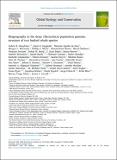Biogeography in the deep : hierarchical population genomic structure of two beaked whale species
Abstract
The deep sea is the largest ecosystem on Earth, yet little is known about the processes driving patterns of genetic diversity in its inhabitants. Here, we investigated the macro- and microevolutionary processes shaping genomic population structure and diversity in two poorly understood, globally distributed, deep-sea predators: Cuvier’s beaked whale (Ziphius cavirostris) and Blainville’s beaked whale (Mesoplodon densirostris). We used double-digest restriction associated DNA (ddRAD) and whole mitochondrial genome (mitogenome) sequencing to characterise genetic patterns using phylogenetic trees, cluster analysis, isolation-by-distance, genetic diversity and differentiation statistics. Single nucleotide polymorphisms (SNPs; Blainville’s n = 43 samples, SNPs=13988; Cuvier’s n = 123, SNPs= 30479) and mitogenomes (Blainville’s n = 27; Cuvier’s n = 35) revealed substantial hierarchical structure at a global scale. Both species display significant genetic structure between the Atlantic, Indo-Pacific and in Cuvier’s, the Mediterranean Sea. Within major ocean basins, clear differentiation is found between genetic clusters on the east and west sides of the North Atlantic, and some distinct patterns of structure in the Indo-Pacific and Southern Hemisphere. We infer that macroevolutionary processes shaping patterns of genetic diversity include biogeographical barriers, highlighting the importance of such barriers even to highly mobile, deep-diving taxa. The barriers likely differ between the species due to their thermal tolerances and evolutionary histories. On a microevolutionary scale, it seems likely that the balance between resident populations displaying site fidelity, and transient individuals facilitating gene flow, shapes patterns of connectivity and genetic drift in beaked whales. Based on these results, we propose management units to facilitate improved conservation measures for these elusive species.
Citation
Onoufriou , A B , Gaggiotti , O E , de Soto , N A , McCarthy , M L , Morin , P A , Rosso , M , Dalebout , M , Davison , N , Baird , R W , Baker , C S , Berrow , S , Brownlow , A , Burns , D , Caurant , F , Claridge , D , Constantine , R , Demaret , F , Dreyer , S , Ðuras , M , Durban , J , Frantzis , A , Freitas , L , Genty , G , Galov , A , Hansen , S S , Kitchener , A C , Martin , V , Mignucci-Giannoni , A A , Montano , V , Moulins , A , Olavarría , C , Michael Poole , M , Suárez , C R , Rogan , E , Ryan , C , Schiavi , A , Tepsich , P , Urban , J , West , K , Olsen , M T & Carroll , E L 2022 , ' Biogeography in the deep : hierarchical population genomic structure of two beaked whale species ' , Global Ecology and Conservation , vol. 40 , e02308 . https://doi.org/10.1016/j.gecco.2022.e02308
Publication
Global Ecology and Conservation
Status
Peer reviewed
ISSN
2351-9894Type
Journal article
Description
Funding: Funding for this research was provided by the Office of Naval Research, Award numbers N000141613017 and N000142112712. ABO was supported by a partial studentship from the University of St Andrews, School of Biology; OEG by the Marine Alliance for Science and Technology for Scotland (Scottish Funding Council grant HR09011); ELC by a Rutherford Discovery Fellowship from the Royal Society of New Zealand Te Aparangi; NAS by a Ramon y Cajal Fellowship from the Spanish Ministry of Innovation; MLM by the European Union’s Horizon 2020 Research and Innovation Programme (Marie Skłodowska-Curie grant 801199); CR by the Marine Institute (Cetaceans on the Frontier) and the Irish Research Council; and MTO by the Hartmann Foundation.Collections
Items in the St Andrews Research Repository are protected by copyright, with all rights reserved, unless otherwise indicated.

